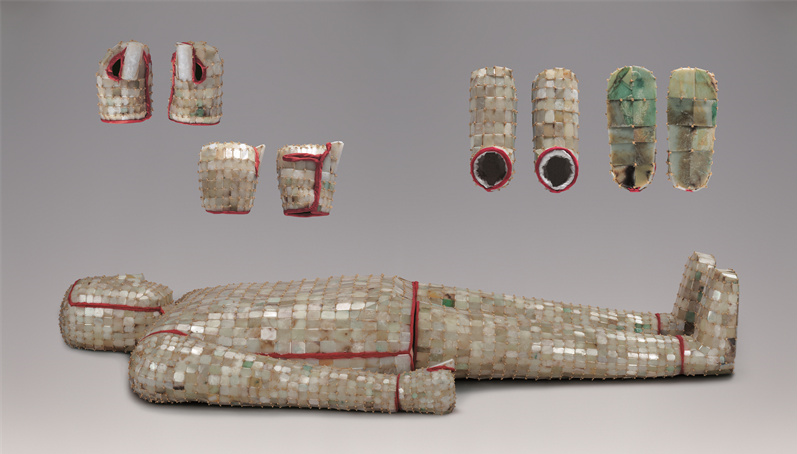Xuzhou Museum (I)
 0 Comment(s)
0 Comment(s) Print
Print E-mail China.org.cn/Xuzhou Museum, January 10, 2023
E-mail China.org.cn/Xuzhou Museum, January 10, 2023
Name:Jade suit
Time:【Western Han dynasty】
Size:Length: 175cm Width: 68cm
Source:Excavated at Shzishan in 1994
To date, 12 complete jade suits have been excavated in China. Most of the suits or surviving plaques have come from sites concentrated in eastern China, particularly Hebei, Shandong, Jiangsu and Henan provinces. These formed parts of the powerful Kingdom of Zhongshan, Lu, Chu and Liang respectively. Although the exact number of plaques composing a jade suit was dependent on the size of the corpse, it took on average 2000 pieces to form one. This jade suit from Shizishan is composed of 4248 jade plagues, sewn with 1576 grams of gold thread. It is the finest example in terms of material that has been excavated so far.
The jade suit is bulky in appearance and has a large abdomen. The facial features, eyes and mouth are depicted through the use of differently shaped plaques. The nose is composed of 7 narrow plaques. Most of the plaques used in the construction of jade suits were rectangular in shape and on average they were 4.5 cm long, 3.5 cm wide and 0.2-0.35 cm thick. However, a range of differently shaped plaques, including triangular, half-moon, round, rhombic and fan-shaped were used for sections such as the gloves, feet and face covers. The jade plagues used for the helmet, face cover and gloves are smaller and more elaborately carved than those used for other parts of the suit, and on average are 1.5-3 cm long and 1-2 cm wide.
In most cases, a disc was used to form the top section of the helmet, thus leaving an opening at the top, but here the opening is ringed by 13 small fan-shaped plagues.
The jade material has been identified as originating from Xinjiang, but we don't know how these materials were transported to the eastern part of China. Tomb robbers have looted the original gold thread and some modern jade plagues replace lost originals.
The banliang coins found in this tomb, which date to the early Western Han, reveal that there are 2 possible owners of this jade suit: Liu Yingke (r.178-174 BC) and Liu Wu (r.174-154 BC).
The unfinished giant tomb structure has led archaeologists to believe that the tomb occupant may have been the third generation King of Chu, Liu Wu, who joined the rebellion with 6 other kingdoms in 154 BC and committed suicide soon after the failure of the rebellion.
However, a large group of terracotta soldiers was found in front of Shizishan, and the jade suit found inside the tomb is particularly delicate. It seems unlikely that the kingdom would have given Liu Wu such a grand burial as this may have risked the possibility that he would pursue his rebellion in the afterlife.
General Zhou Yafu, for example, fell out of favour with the Han imperial court and was imprisoned when he purchased 500 sets of armour and shields for his funeral. He was accused of underground treason, the suspicion being that he would commit treason against the emperor after he died.
Therefore, it seems more likely that the owner of this jade suit is the second King of Chu, Liu Yingke.






Go to Forum >>0 Comment(s)